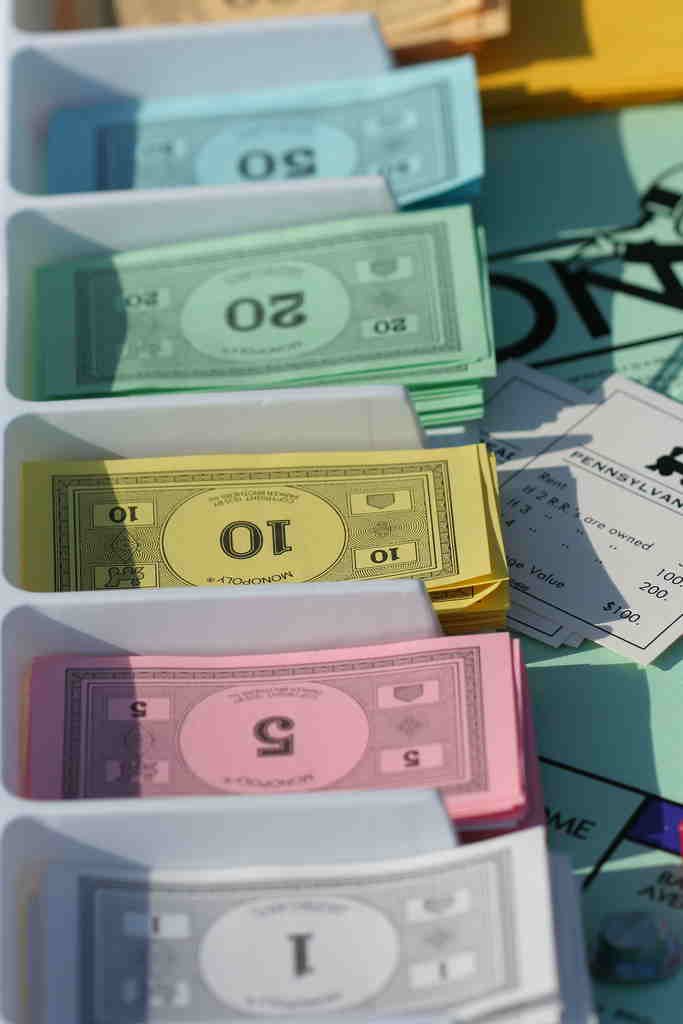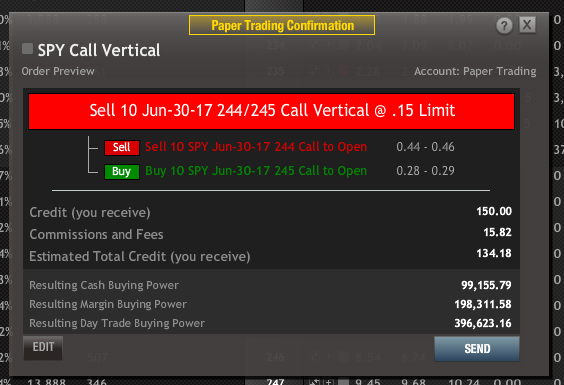Trade without Money? Is it really possible?

I am very sorry to say that there is no real way of earning real money through trading in the stock market without any capital. Risk and profit only go together. You can not make money without risking some. That is just how the market works. There is nothing you can do about that. But before you leave, I can tell you that there may actually be a way of investing into the market without capital. Ever heard of paper trading?
What is a Paper Trade?
Paper trading requires no starting capital at all. That is because (virtual) paper trading is trading with fake or virtual (paper) money. This means that all your risk is fake and only virtual. This of course also means that all your profits from this paper money are only on paper or virtual as well. This may sound boring to some, but it really is not. There are plenty of benefits of paper trading, especially for beginner traders. Nevertheless, paper trading does not necessarily translate into real trading just as good as some think it does. Just because you are profitable in a paper trading account, does not mean that you will be profitable in a real live trading account. There are a variety of reasons why this is the case. I will try to break down the advantages and disadvantages of paper trading, as well as the way I would recommend someone to use paper trading.
Should you Paper Trade?

There are plenty of benefits to paper trading. But this does not mean that paper trading is perfect, paper trading also has some disadvantages.
Pros
- Probably the greatest benefit of paper trading is that it carries no risk whatsoever. Theoretically you can do whatever you want. No matter what happens with your paper trading positions, you won’t lose any real money. Therefore, paper trading is a great way of practicing your trading activities.
- Additionally, paper trading gives you a great introduction to trading. It gives you the opportunity to put what you learned in theory into practice without risking anything.
- Not only is paper trading a good introduction to trading, but also a great introduction to a trading platform. When you sign up to a new broker and don’t know the trading platform that well yet, paper trading is a great way of getting to know it. With paper trading you can easily learn how to use and navigate through everything allowing you to make mistakes that don’t cost you money.
Cons
- Even though paper trading is a great practice medium, it nevertheless is not the same as real trading. Every real trader will tell you that. No matter how serious you try to take it, you will never paper trade exactly like you would trade with real money. This is because you automatically have a different mentality when you are trading with fake money. A human being acts totally different when his/her hard-earned money is at risk. Paper trading is much more forgiving and therefore you will act much less caring.
- Paper trading has unlimited retries. This may be a good thing when practicing, but you don’t have any retries when trading with real money. This again will create less respect for the money and therefore will lead to a different trading behavior.
- Furthermore, many platforms handle paper trading accounts much differently than they handle their real trading accounts. This of course does make sense in some cases. But it doesn’t necessarily make sense in things like commissions and filling times. Usually orders will get filled much faster in paper trading accounts. Some order that get filled in paper trading accounts, would never get filled in real live trading accounts. The same applies for commissions. Many paper trading platforms either do not have commissions or have very cheap commissions. This creates another unreal trading environment.
- Another drawback of paper trading is that it is mostly used on a short term basis. When someone uses paper trading to test out some strategies, he or she normally uses it no longer than a few weeks to months. This is not enough to really see if a strategy is profitable in the long run. Additionally, because paper trading only uses fake money, people just want to try out things fast and see if they work. Understandable, no one wants to sit around and wait many months to see if his/her virtual money would actually create a virtual profit.
- A final big downside of paper trading is that you can not really acquire a good trading mentality. This is one of the things that only can be done through real trading. The emotions of human beings are naturally attached to things that mean a lot to them. Money is one of these things. But there is no way to really get emotionally attached to fake/virtual/simulated/paper trading money. Therefore, paper money losses won’t affect someone as much as real losses would.
Conclusion
Even though paper trading is far from ideal and does not simulate real trading perfectly, I do think that it is a great learning tool and therefore I do recommend it. There really is no real reason why one should not try it. It does not cost anything and it is risk free. One really has nothing to lose when paper trading. I think it is a perfect way of getting your platform and trading to know.
Where to Paper Trade?
There are many different ways to paper trade. For example, you can paper trade with real paper by writing you entry and exit prices down or you can use an online program or you can use your broker platform. Most (good) brokers nowadays do offer paper trading. Usually they allow you to easily switch between your actual live trading account and a virtual trading account. If your broker does not offer this, you may want to consider changing your broker (here are some recommendations) or you have to find an online platform.
I would most definitely recommend using your broker to paper trade. Paper trading with actual paper really is just so much more complicated and unnecessary. Furthermore, it takes away some benefits of paper trading. Besides, many people would easily cheat when paper trading with actual paper, because it is so easy to cheat.
The reasons why I do recommend that you use your broker to paper trade are, because you will get to know this exact platform, which helps you mitigate later mistakes with real money. Moreover, it is just an insanely easy way to paper trade. You won’t have to keep track of anything. The broker will automatically handle everything. They will treat you very similarly to a normal trading account. (Furthermore, it can be quite hard to keep track of the P/L of a complex option strategy/spread and portfolio).
How to Paper Trade properly?
I would say the way you should paper trade really depends on the reason why you want to paper trade in the first place.
If you want to get to know your broker platform and navigating/using it:
I would recommend that you try out as many things as you possibly can. Don’t actually think about your paper trades, just try to order different positions, strategies at different prices to learn how to do that. Additionally, try to understand everything you see. Try to understand your portfolio performance and all the other readings. This will help a lot in later real trading activities. Understanding your personal broker platform is essential and paper trading is a great way to do this. But again, if this is your goal, you should try not to think about the fake money and making a profit with it. Just try out as many different things and get used to the platform. If you do this, you will easily learn the platform by doing stuff. This is one great way to use paper trading, because you could/would never do this with your real money.
If you actually want to test a strategy: (for example my consistently profitable strategy. To learn more about my strategy, click here)
You should try to set all the starting criteria as close to the actual one. With this I mean that you should set your starting amount to your actual real starting amount and actually do trades the same way you would with real money. To ensure that you don’t use more money than you actually could, I highly recommend that you delete the rest. If you can’t do this by yourself, you could contact your broker real fast and they would do it with a pleasure. When testing this new strategy, you should try to act as real as possible. This can’t be done to a full extent, but it can certainly be done to a certain degree. What this means is that you take your time before every entry, don’t allow for any retries and don’t make up any excuses. I often find when paper trading and testing things if I lose I tell myself that the loss just was an exception or I just made a wrong entry. Do not do that. Count every loss and look at your overall P/L. To make it as realistic as possible you could ask yourself, if you theoretically would make this trade with your actual money, before every entry. Don’t think of the fake money as fake money. Act like you care, even though that can be harder than you think. But if you test out a strategy with a ‘not caring mentality’, it won’t be a good test of this strategy, because you didn’t test it the way you would later use it.

Nevertheless, no matter what you do, paper trading still won’t be the same as real trading.
How Long should you Paper Trade before Trading with Real Money?
Many people ask how long one should paper trade, before moving on to real trading. I don’t think there is one correct answer to this question. It also really depends. But I would say that before trading with real money, someone should definitely know his/her broker platform if you now learn how to use your broker platform through paper trading or not, is still up to you. Otherwise, I would say that it depends on if you feel ready for your first real trade. But I would not necessarily say that one has to have had a specific percentage gain in paper trading before trading real money. In the end it really comes down to when someone feels ready and prepared.
Can you Paper Trade Options and other Derivatives or only Stocks? – Virtual Options Trading
Paper trading is not only a good way to practice stock trading with fake money, but it is also a great way to get into other types of trading. Nowadays everybody can paper trade with ease. No matter if you are an option, futures, Forex or whatever kind of trader, you will be able to paper trade options, paper trade futures, paper trade Forex etc. Most brokers allow you to do that.

What a great explanation of paper trading. Whether it’s stocks, options or futures, there are ways to paper trade and what this really means is that you have an opportunity to PRACTICE ! Sure, you may not be a free swinger when using your own money, but you will have some knowledge of how the markets work and this leads to confidence. As in anything, confidence sends you into the arena with your eyes wide open.
Hey Warren,
You are absolutely right!!!
Excellent information and something I have tried in the past. Sadly I found that the reality between paper trading and real-time trading with your own money were two completely different beasts. It was, and is, an excellent way of learning the platform interface without the worry of making mistakes but not, in my opinion, for testing out strategies.
Totally agree!